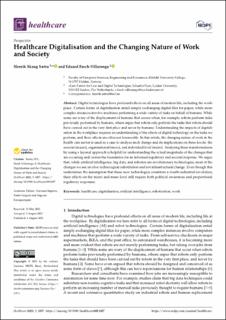| dc.contributor.author | Sætra, Henrik Skaug | |
| dc.contributor.author | Fosch-Villaronga, Eduard | |
| dc.date.accessioned | 2021-09-06T14:23:49Z | |
| dc.date.available | 2021-09-06T14:23:49Z | |
| dc.date.created | 2021-08-06T11:09:47Z | |
| dc.date.issued | 2021 | |
| dc.identifier.citation | Healthcare. 2021, 9 (8), Artikkel 1007. | en_US |
| dc.identifier.issn | 2227-9032 | |
| dc.identifier.uri | https://hdl.handle.net/11250/2773824 | |
| dc.description.abstract | Digital technologies have profound effects on all areas of modern life, including the workplace. Certain forms of digitalisation entail simply exchanging digital files for paper, while more complex instances involve machines performing a wide variety of tasks on behalf of humans. While some are wary of the displacement of humans that occurs when, for example, robots perform tasks previously performed by humans, others argue that robots only perform the tasks that robots should have carried out in the very first place and never by humans. Understanding the impacts of digitalisation in the workplace requires an understanding of the effects of digital technology on the tasks we perform, and these effects are often not foreseeable. In this article, the changing nature of work in the health care sector is used as a case to analyse such change and its implications on three levels: the societal (macro), organisational (meso), and individual level (micro). Analysing these transformations by using a layered approach is helpful for understanding the actual magnitude of the changes that are occurring and creates the foundation for an informed regulatory and societal response. We argue that, while artificial intelligence, big data, and robotics are revolutionary technologies, most of the changes we see involve technological substitution and not infrastructural change. Even though this undermines the assumption that these new technologies constitute a fourth industrial revolution, their effects on the micro and meso level still require both political awareness and proportional regulatory responses. | en_US |
| dc.language.iso | eng | en_US |
| dc.publisher | MDPI | en_US |
| dc.rights | Navngivelse 4.0 Internasjonal | * |
| dc.rights.uri | http://creativecommons.org/licenses/by/4.0/deed.no | * |
| dc.subject | healthcare | en_US |
| dc.subject | digitalisation | en_US |
| dc.subject | artificial intelligence | en_US |
| dc.subject | robotisation | en_US |
| dc.subject | work | en_US |
| dc.title | Healthcare Digitalisation and the Changing Nature of Work and Society | en_US |
| dc.type | Peer reviewed | en_US |
| dc.type | Journal article | en_US |
| dc.description.version | publishedVersion | en_US |
| dc.rights.holder | © 2021 by the authors. | en_US |
| dc.subject.nsi | VDP::Medisinske Fag: 700::Helsefag: 800 | en_US |
| dc.subject.nsi | VDP::Teknologi: 500::Informasjons- og kommunikasjonsteknologi: 550 | en_US |
| dc.source.volume | 9 | en_US |
| dc.source.journal | Healthcare | en_US |
| dc.source.issue | 8 | en_US |
| dc.identifier.doi | https://doi.org/10.3390/healthcare9081007 | |
| dc.identifier.cristin | 1924342 | |
| dc.source.articlenumber | 1007 | en_US |
| cristin.ispublished | true | |
| cristin.fulltext | original | |
| cristin.qualitycode | 1 | |

